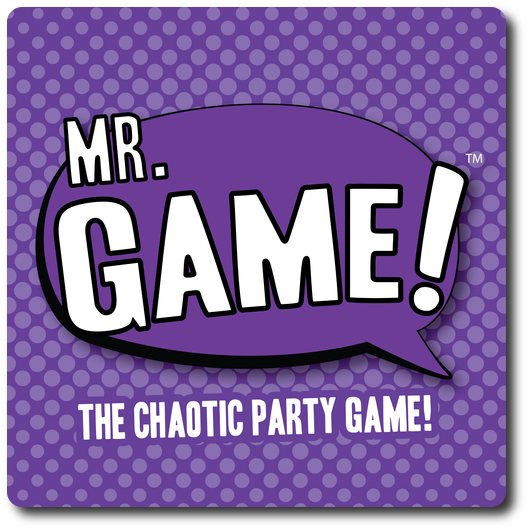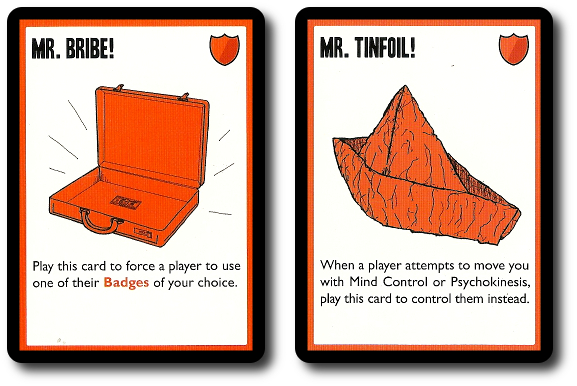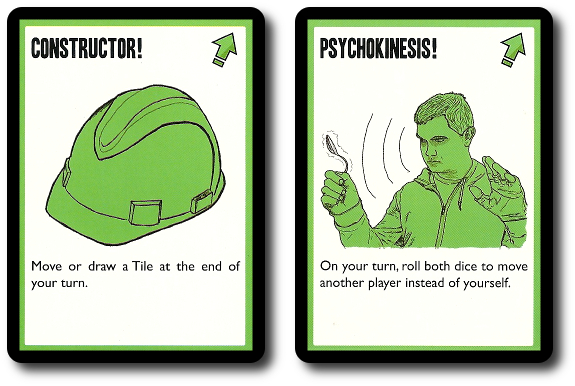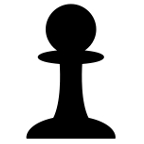
The Basics:
- For ages 6 and up (publisher suggests 12+)
- For 2 to 8 players
- Variable game play length
Geek Skills:
- Active Listening & Communication
- Counting & Math
- Logical & Critical Decision Making
- Reading
- Risk vs. Reward
- Memorization
- Cooperative & Team Play
- Imagination
- Reflex & Speed
Learning Curve:
- Child – Easy
- Adult – Easy
Theme & Narrative:
- Mr. Game, that’s my name. That name again is Mr. Game.
Endorsements:
- Gamer Geek rejected!
- Parent Geek approved!
- Child Geek approved!
Overview
For every rule book there is a Frequently Asked Question (FAQ) sheet. For every typo on a card there is an errata list. Mistakes are made and not every corner can be covered. Game designers go out of their way to ensure that their game has rules that can be followed and understood. Well, not every game designer. This game, for example, was purposely left with holes.
Mr. Game!, designed by Frank DiCola and published by Margrave Games, is comprised of 1 game board, 2 standard four-sided dice, 104 Mr. Game cards, 8 Player pieces, 8 Player cards, 18 tiles, 2 Goal markers, and 4 blank cards for game customization. Also included is a booklet of alternative rules. The game board is made of thick cardboard and the cards are as thick and as durable as your standard playing card. The tiles are also made of cardboard, but are not nearly as thick as the game board. The dice, pieces, and markers are made of plastic.
Wanna Game?
To set up the game, first place the game board in the middle of the playing area.
Second, have each player select a Player piece and place it on the “1” space found on the game board. Place any Player pieces not selected back in the game box.
Third, shuffle all the Mr. Game cards and place them face-down in a stack next to the game board. This is the draw deck for the duration of the game.
Fourth, shuffle all the tiles and place them face-down next to the draw deck.
Fifth, place 1 Goal marker on the “4” space on the game board.
That’s it for game set up. Before you begin, select one player to act as “Mr. Game” (or “Ms. Game”). Who is this Game character of which I speak? Allow me to make the introductions…
Players, Meet Mr. Game
“Mr. Game” is a title given to 1 player who will act as the final judge when it comes to rule disputes. Of which there may be a lot depending on the creativity of the group and their overall level of dislike for their opponents. More importantly, Mr. Game will keep the game going. Instead of players getting bogged down in rule disputes, the Mr. Game character will hear both sides of the argument and make a ruling, allowing the game to proceed.
While this may sound like a role perfectly designed for a Rules Lawyer or a tyrant (which are actually the same thing), it’s not an easy job. Mr. Game! allows players to interpret the rules as they see fit and some of the rules provided are blatantly lacking detail. This means that objectivity is kicked right out the windows and everyone gets to play the game using rules that are highly subjective (not to mention slanted). Mr. Game has to keep all these rules in mind and maintain a level of sanity. Worse yet, Mr. Game is subject to his own rules and cannot break any made during the game. The upside is that Mr. Game gets to do some very interesting and creative problem solving.
Finally, Mr. Game is not meant to be popular, but they are somewhat immune to everything in the game except their own stupidity. No matter how players feel about a rule defined by Mr. Game, as long as the majority thinks it’s fair, the rule stands. However, the very moment the majority don’t much care for the current Mr. Game, they can vote the player out of office. In which case, a new Mr. Game is selected. Now the old Mr. Game gets to play with a bunch of opponents who might be thinking how best to “get even” for past injustices.
Obvious target of revenge is obvious…
GAME ON!
Mr. Game! is played in turns with no set number of turns per game. A player’s turn is summarized here and starts out very simple. As the game progresses, the players will add more rules.
Step 1: Roll Dice
The first thing a player does is take both dice and roll them (unless the player is “stuck” on a space). The player then selects the rolled result of 1 of the 2 dice, not both, and moves that number of spaces on the game board. The player can move to any adjacent space, but cannot move diagonally or through Null spaces.
If the player rolls doubles, only 1 number is still used for movement. In addition, the player is punished for obviously showing off by rolling two of the same number. They must discard 1 Powerup of their choice if they should currently have one.
Step 2: Resolve Space
When the player ends their movement, they must resolve the space they have landed on. The game board has a default configuration that all games use when they begin. As the game progresses, the tiles are placed on top of the game board spaces, altering what they are and their effect.
Normal Space
These are blank and have no effect on the player.
Exclamation Space
These spaces are marked with an exclamation mark and allow the player to draw 1 card. There are three different types of cards. Regardless of the type, they will have an impact on the game.
- Action Cards: These cards are played as soon as they are drawn and then discarded after they are resolved.

- Badge Cards: These cards are kept hidden when they are drawn and can be used during the game when it’s the player’s turn or during an opponent’s turn.

- Powerups Cards: These cards are played as soon as they are drawn and placed in front of the owning player, face-up. The bonus provided by the Powerup can be immediately used and are available for the duration of the game.

Number Space
These spaces are marked with a number (1 through 4). These spaces act as “goals”. If the current number the player landed on is the goal, they win the game. Otherwise, the space as the same effect as a normal space.
Portal Space
These spaces are marked with a swirling pinwheel. When landed on, the player moves their Player piece to any other Portal space.
Web Space
These spaces look like a giant spider made it their home. The player is stuck on this space. Instead of rolling to move, they draw 1 card.
Winning the Game
The first player to end their turn on a space that also contains a Goal marker is the winner of the game.
Game Variants
Mr. Game! was purposely designed to be customized. A number of alternative ways to play the game are provided and the players are highly encouraged to make up their own new methods to have fun, as well. A few of the more interesting alternative ways to play are summarized here.
Mr. Undead Game!
This alternative method of play divides the players into teams, where one side are the hapless humans and the others are brain eating zombies. Game play is more or less the same except that zombie players win the game when all of the human players have been turned into zombies. The humans win if they can get to the goal and escape.
Land Mines
The tiles are randomly placed on the game board. When they are landed on, the tile is flipped over and resolved. This is in addition to the space the player will eventually land on, as well.
To learn more about Mr. Game!, visit the game’s website.
Final Word
 The Child Geeks liked how the game ramped up with its rules, starting off simple and then becoming more and more complex. They especially liked the fact that they were the ones making it so. According to one Child Geek, “I’ve never played a game before where I got to make up the rules as we played.” Many of the Child Geeks thought that the game would be easy to cheat, but it turns out that everyone acted as their own police force, constantly questing new rules, ensuring that old ones were followed, and taking the time to carefully consider how best to go about playing the game. In short, it was a wonderful time. As one Child Geek put it, “The game is so much more fun when you get to play it the way you want it.” When all the games were over, the Child Geeks voted to approve Mr. Game!
The Child Geeks liked how the game ramped up with its rules, starting off simple and then becoming more and more complex. They especially liked the fact that they were the ones making it so. According to one Child Geek, “I’ve never played a game before where I got to make up the rules as we played.” Many of the Child Geeks thought that the game would be easy to cheat, but it turns out that everyone acted as their own police force, constantly questing new rules, ensuring that old ones were followed, and taking the time to carefully consider how best to go about playing the game. In short, it was a wonderful time. As one Child Geek put it, “The game is so much more fun when you get to play it the way you want it.” When all the games were over, the Child Geeks voted to approve Mr. Game!
 The Parent Geeks were very skeptical about Mr. Game!, believing it to be an exercise in chaos and futility, especially when they learned that rules and objectives could change every turn. As one Parent Geek put it, “Such a game sounds like an exercise in patience rather than an exercise in fun.” The first couple of games were solid, with the Parent Geeks understanding how the game progressed and changed at the same time. A number of Mr. Game title holders were voted out of office and some of the rules that were allowed were out of this world bizarre. At all times, however, the game and the players stayed well-grounded and enjoyed themselves. As one Parent Geek put it, “This is like no game I have ever played before and I just played it 10 minutes ago!” Yes, the games can feel that different. When all the votes were in, the Parent Geeks highly approved of and endorsed Mr. Game!
The Parent Geeks were very skeptical about Mr. Game!, believing it to be an exercise in chaos and futility, especially when they learned that rules and objectives could change every turn. As one Parent Geek put it, “Such a game sounds like an exercise in patience rather than an exercise in fun.” The first couple of games were solid, with the Parent Geeks understanding how the game progressed and changed at the same time. A number of Mr. Game title holders were voted out of office and some of the rules that were allowed were out of this world bizarre. At all times, however, the game and the players stayed well-grounded and enjoyed themselves. As one Parent Geek put it, “This is like no game I have ever played before and I just played it 10 minutes ago!” Yes, the games can feel that different. When all the votes were in, the Parent Geeks highly approved of and endorsed Mr. Game!
 The Gamer Geeks found the game’s concept to be entertaining, but not in practice. As one Gamer Geek put it, “This is not a game you play but rather juggle. You cannot win until you are either lucky or you are able to manipulate the rules in such a way as to make it impossible to lose.” Another Gamer Geek said, “I think the game would work fine as a game for a party with people who don’t know much about games or the hobby, but I don’t see this game ever being enjoyed by someone who takes their game playing seriously.” What the Gamer Geeks didn’t like is what makes Mr. Game! unique. As such, the Gamer Geeks and Mr. Game! were destined to never be friends.
The Gamer Geeks found the game’s concept to be entertaining, but not in practice. As one Gamer Geek put it, “This is not a game you play but rather juggle. You cannot win until you are either lucky or you are able to manipulate the rules in such a way as to make it impossible to lose.” Another Gamer Geek said, “I think the game would work fine as a game for a party with people who don’t know much about games or the hobby, but I don’t see this game ever being enjoyed by someone who takes their game playing seriously.” What the Gamer Geeks didn’t like is what makes Mr. Game! unique. As such, the Gamer Geeks and Mr. Game! were destined to never be friends.
 Mr. Game! is unique. Not only is it a game with real rules and a real objective, but it’s also very much an open sandbox, where players are encouraged to tweak, twist, break, and crunch different rules together to form new and exciting ways to lose. It makes for a very interesting game environment to traverse and any tactical and strategic tricks a player might have learned in the past are both tested and tossed.
Mr. Game! is unique. Not only is it a game with real rules and a real objective, but it’s also very much an open sandbox, where players are encouraged to tweak, twist, break, and crunch different rules together to form new and exciting ways to lose. It makes for a very interesting game environment to traverse and any tactical and strategic tricks a player might have learned in the past are both tested and tossed.
When I first started to play the game, I was certain it was going to be a lot like Fluxx, a card game where the rules change constantly, as does the goal of the game. I was partially correct. While Fluxx and Mr. Game! share similarities when it comes to shifting objectives and guidelines, Fluxx has rules that cannot be broken. Technically, nor does Mr. Game!, but that’s a matter of interpretation. With Mr. Game!, the objective is always clear, although it might shift. What is never clear is the game rules. Or, better put, all the game rules. What a player could not do on their last turn, they suddenly can on their next. Even more interesting, each game is different as the role of Mr. Game is passed to a new player with their own unique ideas about how the game should be played.
The end result is a very unique and very simple board game that is anything but. Rules from different games will make their way into Mr. Game! and previous game playing experiences will affect decisions. Game play could be kept so simple as to make it little more than a roll-and-move experience or so complex as to almost need a checklist to ensure you are doing everything correctly. Games could take as little as 5 minutes or as long as multiple hours (not that Mr. Game should allow it, however). This is a game that comes in a box but has no defined boundaries. It has a game board, but the game itself is not found there. The game is defined and refined by the players repeatedly from the very first role to the very last rule.
Such a game is going to tickle the fancy of many who enjoy a game playing experience that is always different and lacks much in the way of structure. This makes Mr. Game! a great game to play with mixed groups, such as those found at parties and family gatherings. For the serious gamer who is looking for a challenge and a strict rule-set that allow for tactical and strategical thinking, Mr. Game! is going to be slightly less painful than a kick to the head. The value of this game is not the game itself, but the environment in which it’s played. Mr. Game! needs space to grow and patience from the players. If you have neither the time, creativity, or patience, then Mr. Game! is not for you. If, however, you do enjoy watching a game morph, move, and manifest itself in different ways right before your eyes, then Mr. Game! will be a welcomed visitor.
As for me. Mr. Game! is going to live in my game closet and will be welcome to attend all my family gatherings. Especially when there are family members visiting I do not like.
This game was given to Father Geek as a review copy. Father Geek was not paid, bribed, wined, dined, or threatened in vain hopes of influencing this review. Such is the statuesque and legendary integrity of Father Geek.



